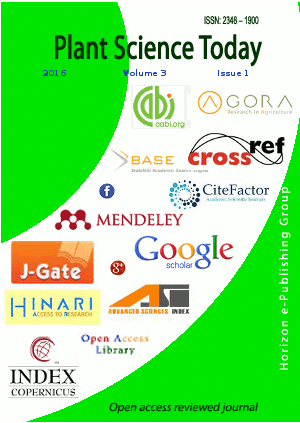Taxonomic studies of the genus Tephrosia Pers. (Papilionaceae) in Nigeria
DOI:
https://doi.org/10.14719/pst.2016.3.1.166Keywords:
Tephrosia, Papilionaceae, taxonomy, morphology, palynology, distribution, NigeriaAbstract
The relationship between eleven Tephrosia species occurring in Nigeria was examined using a number of taxonomic tools. Fresh and herbarium specimens were used for this purpose and methods followed conventional taxonomic practice. Although the species occur in savanna ecosystems, herbarium collections revealed an abundant distribution in the southern part of Nigeria. Morphometric studies revealed that four quantitative characters viz: leaflet length, lamina length, fruit length and pedicel length can be used to delimit members of this genus. Based on the cluster analysis using average linkage within group, the closest species are T. leptostachya and T. purpurea with the shortest distance measure (0.713). T. linearis has the smallest leaflet, in length and width. Further morphological studies also showed that T. vogelii has the largest pod while T. barbigera has the highest number of seeds per pod. Generally, the species have very short petiolule ranging between 0.2cm and 0.3cm in length, on the average. Foliar micro-morphological studies also showed that the species generally possess polygonal cells with straight to curved anticlinal walls and anisocytic stomata types while pollen studies revealed tricolporate pollen grains to be predominant within the taxa. Although, the present study has added to the existing information regarding Tephrosia species, it also suggests further research to ascertain its taxonomic position within the Papilionaceae.Downloads
References
Barnes, D.K. & R.H. Freyre 1967. Recovery of natural insecticides from Tephrosia vogelii. III. An improved procedure for sampling and assaying rotenoid content in leaves. Economic Bot 21:93-8. http://dx.doi.org/10.1007/BF02897179
Brummitt, R.K. 1968. New and little known species from the Flora Zambesiaca area. XX. Tephrosia. Bol Soc Brot ser 2(41):24–351
Erdtman, G. 1943. An Introduction to Pollen Analysis. Waltham Mass. 239 pp.
Erdtman, G. 1952. Pollen Morphology and Plant Taxonomy. Angiosperms. Almqvist and Wiksell, Stockholm. 539 pp.
Erdtman, G. 1960. The acetolysis method; a revised description. Svensk Bot. Tidskr, 54:561-564.
Gaskins, M.H., G.A. White, and F.W. Martin 1972. Tephrosia vogelii; A Source of Rotenoids for Insecticidal and Piscicidal Use. US Dept Agricultural Technol Bull 1445.
Hutchinson, J. and J.M. Dalziel 1958. Flora of West Tropical Africa (Vol. 1 Pt. 2). Crown Agents for Oversea Governments and Administrations, Millbank, London. pp505-587.
Ibrahim, A.J., A.E. Ayodele., A.I. Jegede and Y.F. Kunle 2006. Comparative Studies of Khaya A. Juss. (Meliaceae) in Nigeria. African Journal of Biotechnology. 5(11):1154-1160.
Kadiri, A.B. and A.E. Ayodele 2003. Comparative Leaf micro-morphological Characters of the Nigerian Species of Rauvolfia Linn. (Apocynaceae). Bioscience Research Communications. 15(6):35-41.
Lewis, G., B. Schrire., B. Mackinder. and M. Lock 2005. Legumes of the world. p. 386. Royal Botanic Gardens, Kew:London.
Olowokudejo, J.D. 1999. Comparative Morphology of leaf epidermis in the genus Annona (Annonaceae) in West Africa. Phytomorphol., 40: 407 – 422.
Phillips, B.G. 1986. Webster Third New International Dictionary of the English language. Merrian- Webster Incorporation U. S. pp 1, 044
Salisbury, E.J. 1927. On the causes of and ecological significance of stomatal frequency, with special reference to the woodland flora. Phil. Trans. R. Soc. 216B, 1-65.
Schrire, B.D. 2005. Tribe Millettieae. In: Lewis, G., Schrire, B., Mackinder, B. and Lock, M. (eds) Legumes of the world. Royal Botanic Gardens, Kew, 367–387.
Soladoye, M.O. and G.P. Lewis 2003. A Checklist of Nigerian Legumes. Center for Environmental Research and Development (CENRAD), Ibadan. 141pp.
Soladoye, M.O., M.A. Onakoya., E.C. Chukwuma and M.A. Sonibare 2010. Morphometric study of the genus Senna Mill. in South-western Nigeria. African Journal of Plant Science. 4 (3): 044-052.
Sowunmi, M.A. 1973. Pollen grains of Nigerian plants. Grana 13:145–186. http://dx.doi.org/10.1080/00173137309429891
Stace C.A. 1965. Cuticular studies as an aid to plant taxonomy. Bulletin of the museum (National History). Botany 4:1-78.
Stern, K. R. 2000. Introductory plant biology, MacGraw-Hill Company Inc. United States of America, pp: 630.
Watson, L. 2008. Tephrosia Pers. Syn. Pl. 1:328 (1806) Current Scientific Description
Downloads
Published
How to Cite
Issue
Section
License
Copyright and Licence details of published articles
Authors who publish with this journal agree to the following terms:
- Authors retain copyright and grant the journal right of first publication with the work simultaneously licensed under a Creative Commons Attribution License that allows others to share the work with an acknowledgement of the work's authorship and initial publication in this journal.
- Authors are able to enter into separate, additional contractual arrangements for the non-exclusive distribution of the journal's published version of the work (e.g., post it to an institutional repository or publish it in a book), with an acknowledgement of its initial publication in this journal.
Open Access Policy
Plant Science Today is an open access journal. There is no registration required to read any article. All published articles are distributed under the terms of the Creative Commons Attribution License (CC Attribution 4.0), which permits unrestricted use, distribution, and reproduction in any medium, provided the original author and source are credited (https://creativecommons.org/licenses/by/4.0/). Authors are permitted and encouraged to post their work online (e.g., in institutional repositories or on their website) prior to and during the submission process, as it can lead to productive exchanges, as well as earlier and greater citation of published work (See The Effect of Open Access).









